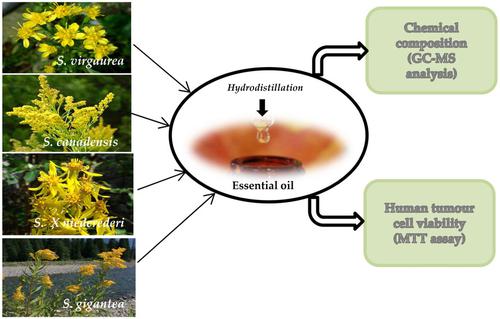当前位置:
X-MOL 学术
›
Chem. Biodivers.
›
论文详情
Our official English website, www.x-mol.net, welcomes your
feedback! (Note: you will need to create a separate account there.)
Chemical composition and antiproliferative effect of essential oils of four Solidago species (S. canadensis, S. gigantea, S. virgaurea and S.× niederederi)
Chemistry & Biodiversity ( IF 2.3 ) Pub Date : 2020-10-16 , DOI: 10.1002/cbdv.202000685 Joice Guileine Nkuimi Wandjou 1 , Luana Quassinti 1 , Zigmantas Gudžinskas 2 , David U Nagy 3 , Kevin Cianfaglione 4, 5 , Massimo Bramucci 1 , Filippo Maggi 1
Chemistry & Biodiversity ( IF 2.3 ) Pub Date : 2020-10-16 , DOI: 10.1002/cbdv.202000685 Joice Guileine Nkuimi Wandjou 1 , Luana Quassinti 1 , Zigmantas Gudžinskas 2 , David U Nagy 3 , Kevin Cianfaglione 4, 5 , Massimo Bramucci 1 , Filippo Maggi 1
Affiliation

|
There is a growing interest in the research of natural products with potent activity in the prevention and treatment of diseases. Thereby, essential oil phytochemicals have demonstrated broad bioactivities. This study highlights the chemical composition of essential oils obtained from the leaves and inflorescences of diverse species of the genus Solidago (Solidago canadensis, Solidago gigantea, Solidago virgaurea and Solidago×niederederi), also known as Goldenrod, through GC/MS analysis, and their antiproliferative activity on three human tumor cell lines (MDA‐MB 231, A375 and HCT116) by the MTT assay. The most represented chemical classes in the essential oils were oxygenated sesquiterpenes, sesquiterpene hydrocarbons, oxygenated monoterpenes and monoterpene hydrocarbons, with a remarkable contribution of compounds such as germacrene D (3.89–19.51 %), α‐pinene (3.59–18.82 %), bornyl acetate (3.30–12.73 %) and caryophyllene oxide (3.07–9.18 %). Chemical quali‐ and quantitative differences were noticed between the leaves and flowers of the same species, as well as between the studied species. The MTT assay showed that the essential oils from the leaves were more active than those from the flower ones. The essential oil having the highest impact on cell viability was that from S.×niederederi (IC50=12.93, 6.72, and 6.82 μg/ml), followed by S. virgaurea (IC50=13.39, 7.96, and 8.36 μg/ml) and finally S. gigantea (IC50=18.04, 5.94, and 8.10 μg/ml) on MDA‐MB 231, A375 and HCT116 cell lines, respectively. The essential oil from S. canadensis showed the lowest activity (IC50=29.33, 12.63, and 18.03 μg/ml, respectively). Taken together, these findings highlight the Solidago species as good sources of cytotoxic compounds. Further studies are encouraged on the in vivo effects and safety of these products.
中文翻译:

四种一枝黄花(S. canadensis、S. gigantea、S. virgaurea 和 S.× niederederi)精油的化学成分和抗增殖作用
人们对在预防和治疗疾病方面具有强大活性的天然产物的研究越来越感兴趣。因此,精油植物化学物质已显示出广泛的生物活性。本研究通过 GC/MS 分析,重点介绍了从一枝黄花属(加拿大一枝黄花、大一枝黄花、一枝黄花和一枝黄花)的叶子和花序中提取的精油的化学成分,以及它们的化学成分。 MTT 测定对三种人类肿瘤细胞系(MDA-MB 231、A375 和 HCT116)的抗增殖活性。精油中最具代表性的化学类别是氧化倍半萜、倍半萜烃、氧化单萜和单萜烃,其中锗烯 D (3.89-19. 51 %)、α-蒎烯 (3.59–18.82 %)、醋酸冰片酯 (3.30–12.73 %) 和石竹烯氧化物 (3.07–9.18 %)。注意到同一物种的叶子和花朵之间以及研究物种之间的化学质量和数量差异。MTT 分析表明,叶子中的精油比花中的精油更活跃。对细胞活力影响最大的精油是来自 S.×niederederi(IC50=12.93、6.72 和 6.82 μg/ml),其次是 S. virgaurea(IC50=13.39、7.96 和 8.36 μg/ml)和最后分别在 MDA-MB 231、A375 和 HCT116 细胞系上的 S. gigantea(IC50=18.04、5.94 和 8.10 μg/ml)。S. canadensis 精油的活性最低(IC50 分别为 29.33、12.63 和 18.03 μg/ml)。综合起来,这些发现突出了 Solidago 物种是细胞毒性化合物的良好来源。鼓励对这些产品的体内效应和安全性进行进一步研究。
更新日期:2020-10-16
中文翻译:

四种一枝黄花(S. canadensis、S. gigantea、S. virgaurea 和 S.× niederederi)精油的化学成分和抗增殖作用
人们对在预防和治疗疾病方面具有强大活性的天然产物的研究越来越感兴趣。因此,精油植物化学物质已显示出广泛的生物活性。本研究通过 GC/MS 分析,重点介绍了从一枝黄花属(加拿大一枝黄花、大一枝黄花、一枝黄花和一枝黄花)的叶子和花序中提取的精油的化学成分,以及它们的化学成分。 MTT 测定对三种人类肿瘤细胞系(MDA-MB 231、A375 和 HCT116)的抗增殖活性。精油中最具代表性的化学类别是氧化倍半萜、倍半萜烃、氧化单萜和单萜烃,其中锗烯 D (3.89-19. 51 %)、α-蒎烯 (3.59–18.82 %)、醋酸冰片酯 (3.30–12.73 %) 和石竹烯氧化物 (3.07–9.18 %)。注意到同一物种的叶子和花朵之间以及研究物种之间的化学质量和数量差异。MTT 分析表明,叶子中的精油比花中的精油更活跃。对细胞活力影响最大的精油是来自 S.×niederederi(IC50=12.93、6.72 和 6.82 μg/ml),其次是 S. virgaurea(IC50=13.39、7.96 和 8.36 μg/ml)和最后分别在 MDA-MB 231、A375 和 HCT116 细胞系上的 S. gigantea(IC50=18.04、5.94 和 8.10 μg/ml)。S. canadensis 精油的活性最低(IC50 分别为 29.33、12.63 和 18.03 μg/ml)。综合起来,这些发现突出了 Solidago 物种是细胞毒性化合物的良好来源。鼓励对这些产品的体内效应和安全性进行进一步研究。











































 京公网安备 11010802027423号
京公网安备 11010802027423号